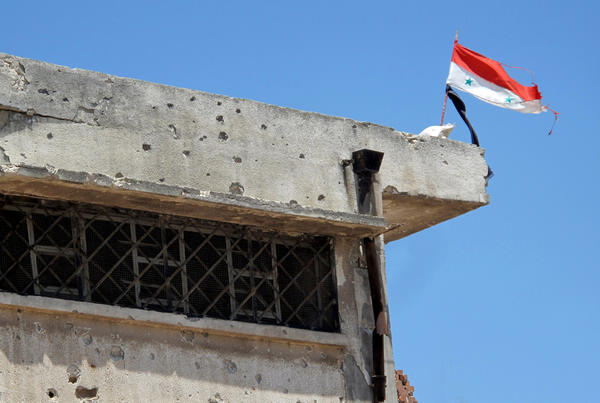A scarred city with the wounds of war
Updated: 2012-05-17 07:46
By Li Lianxing (China Daily)
|
|||||||||||
We were strictly forbidden from entering the alleyways because they are out of the guards' control. A handful of women walked swiftly down the main road. They all wore full veils and so it was impossible to tell if they were sad, terrified or just resigned. Only a few children, we saw no more than five, gave us beautiful smiles and flashed a "victory" gesture.
 |
|
A Syrian national flag flying from a ruined house, previously used as a food store in Homs. |
In the city center, an area under the control of government forces, most of the shops were closed and the air was rank with the stench of garbage. "One of the biggest problems in Homs is that the street cleaners have been killed and so no one is disposing of the trash," said the governor. "Anyone who comes out to do this job is likely to be threatened in surprise attacks."
An elderly man came to talk to us while we were waiting to discover whether we would be allowed to enter another destroyed area of the town. "I have been living in this city for 83 years and previously people were so peaceful and nice," he said. "Please, please let the violence stop and let the terrorists get out of this place."
His words underlined the fact that Syrian situation has been gradually drifting in another direction, one more daunting and challenging than the current military conflict: the specter of terrorism.
Terrorist cloud
Of course, there are armed opponents of the Assad regime fighting in Syria, but, according to a number of observers, some recent attacks have shown strong indications that terrorist groups were involved. Those indications raised a wave of panic as the reality of the situation began to sink in. People realized that the conflict is not simply being played out between the government and opposition, but is developing into a more complex situation, one featuring other, more dangerous players.
We were due to fly out of Damascus on the afternoon of May 10. However, before we left the country, we were able to witness the aftermath of two massive explosions that occurred on the main road to the airport during the morning rush hour.
When the separate blasts came at around 8:00 am, we were having breakfast at a hotel in the city center. Although we were 10 km from the explosions, we still heard them.
Later, we were told that we could visit the site, an office of the Syrian intelligence agency, so we stopped packing and drove to the scene. By the time we arrived, the UN workers investigating the site had already left the area.
What first caught my eye was the shattered glass from a brand new Audi SUV parked 100 meters from the epicenter of the explosion, but the damage closer to the craters was much more daunting.
Dozens of taxies, coaches and vans had been twisted into empty, black structures, glass and blood covered the road and the front wall of the 11-story building was missing. Approximately 30 meters from the building, there were two craters in the asphalt road. The bigger of the two was approximately 15 meters wide and 3 meters deep.
Today's Top News
President Xi confident in recovery from quake
H7N9 update: 104 cases, 21 deaths
Telecom workers restore links
Coal mine blast kills 18 in Jilin
Intl scholarship puts China on the map
More bird flu patients discharged
Gold loses sheen, but still a safe bet
US 'turns blind eye to human rights'
Hot Topics
Lunar probe , China growth forecasts, Emission rules get tougher, China seen through 'colored lens', International board,
Editor's Picks

|

|

|

|

|

|





